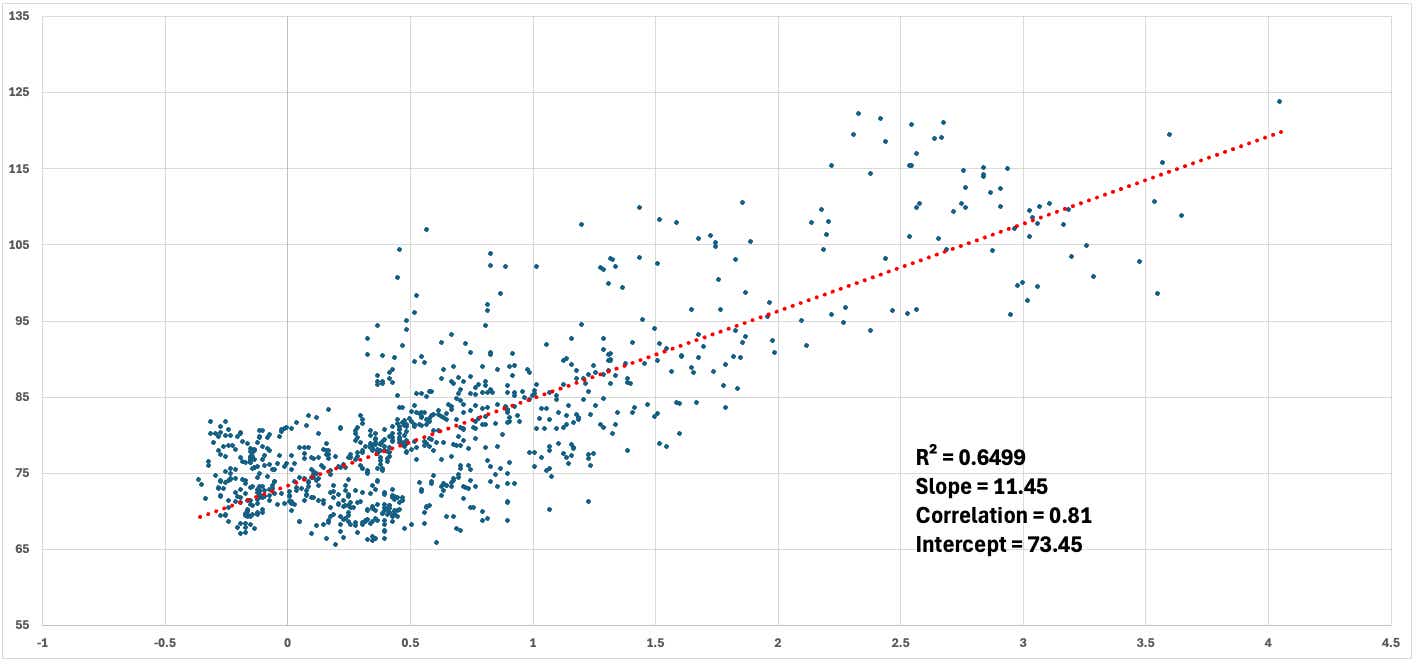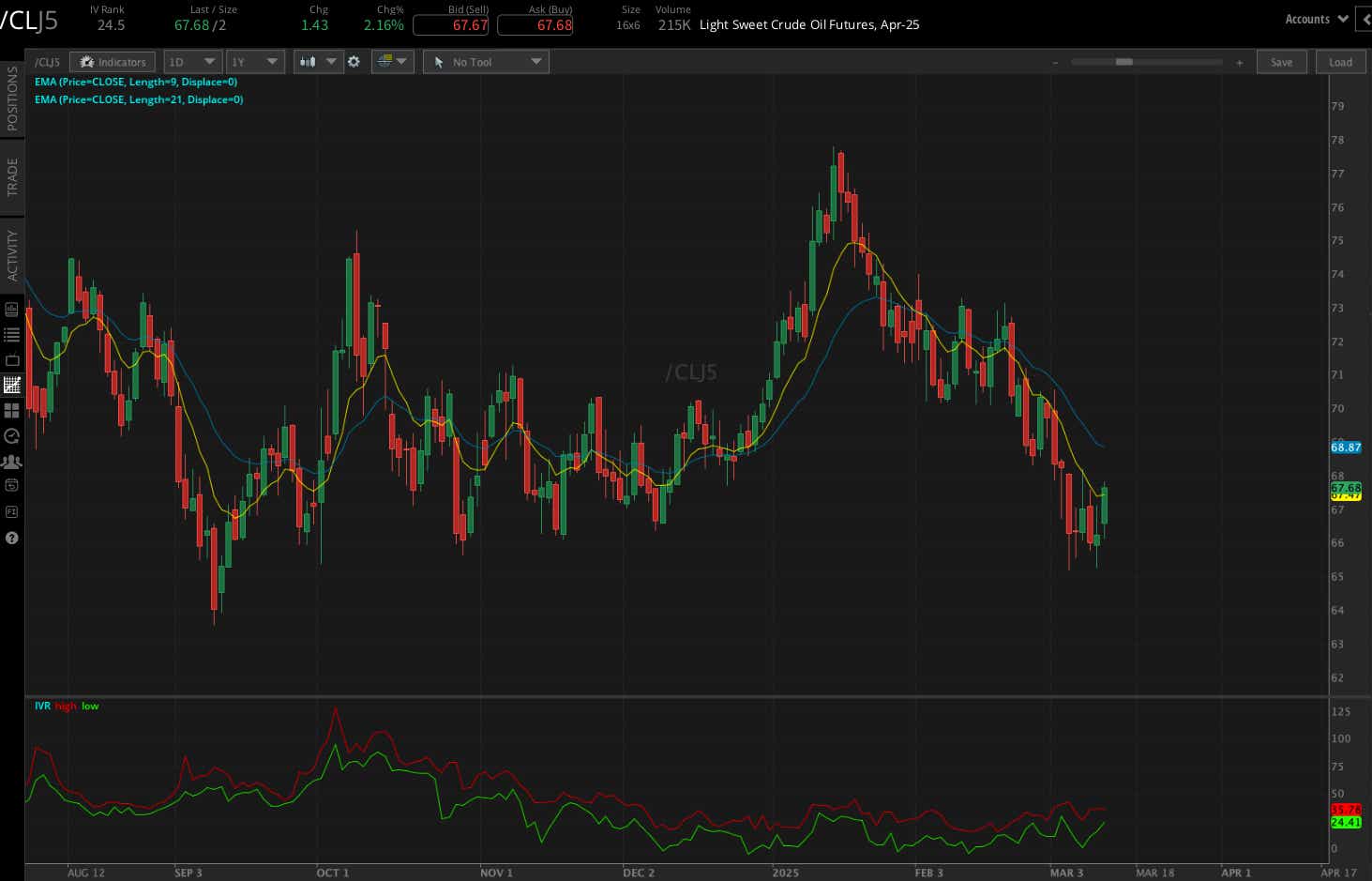Crude Oil Stages Comeback After Prices Drop to Six-Month Low

Crude Oil Stages Comeback After Prices Drop to Six-Month Low
Rallies as broader market sentiment Improves: sees upside after unchanged OPEC demand forecast
- Crude oil prices are rallying amid a broader uptick in market sentiment.
- OPEC+ is holding steady on its demand forecast, breaking with other forecasters.
- The crude oil prompt spread backwardation signals that there is still some tightness in the market.
Crude oil futures (/CLJ5) were trading near the lowest levels since September earlier this week. Today, prices are up over 2% as buyers come back into the commodity that has been beaten down by increasing trade tension between the U.S. and global trading partners. A revival in sentiment in the equity market accompanied the rally in crude oil prices.
After an initial rally at the start of the year that saw crude oil prices rise to $77.68 per barrel, traders have aggressively sold the commodity as enthusiasm over the new Trump administration faded and attention shifted to U.S. trade measures that many fear would affect global demand.
So far, tariffs haven’t specifically targeted oil, but trade measures on Canadian oil could go into effect on April 2 if a deal among the U.S., Canada and Mexico isn’t reached by then. Currently, a 10% tariff on Canadian energy products is in place, but ongoing talks between trade representatives could see the level drop to zero or near it.
While tariffs aren’t directly impacting global oil trade yet, the broader concern about slowing economic growth has punished prices because traders expect lower demand for the commodity because of trade measures that are expected to slow global growth.
OPEC+ to start releasing more oil
The Organization of Petroleum Exporting Countries, or OPEC, and its broader alliance, OPEC+, kept its demand growth forecast unchanged at +1.45 million barrels a day for 2025. However, other industry groups have lowered their forecasts recently, including the International Energy Agency (IEA), which pegs growth at +1.1 million barrels a day this year.
OPEC also kept its forecast for economic growth the same at +3.1% for 2025. The cartel did mention tariffs but assumed the influence on growth would be outdone by strong consumer demand. OPEC’s Monthly Oil Market Report (MOMR) stated:
“The industrial sector is projected to pick up gradually as well, although uncertainties remain, especially as it remains to be seen how and to what extent potential tariffs and other policy measures will play out. So far, they are not anticipated to materially impact current underlying growth assumptions, but the outcome of potentially further rising uncertainties and the scope and significance of potential tariffs and other policy measures will need close monitoring.”
Earlier this month, OPEC signaled it would allow more oil onto the market starting in April by rolling back some voluntary production cuts. The move would release an additional 138,000 barrels a day onto the market in April. That is a rather small amount of global consumption, but it hints that OPEC could be playing a political angle under pressure from the Trump administration. Still, Russia’s Deputy Prime Minister, Alexander Novak, said that the group could reverse the decision if market conditions turn against oil.
Prompt spread remains resilient amid the sell-off
The prompt spread for U.S. prices remains in backwardation, with the front-month contract holding a premium of 30 cents over the next month’s contract. That structure is typically seen as a bullish signal for oil traders because it reflects a tight physical market where demand for oil now is higher than demand for oil further out in time.
A regression analysis on crude oil and the prompt spread going back to 2019 reveals that oil prices should be trading at about $77 per barrel based on the current prompt spread. While other factors are likely influencing oil outside of that relationship, it does suggest oil prices have some upside assuming the prompt spread holds in backwardation.

Trading crude oil
Crude oil prices have traded in a steady downward range since mid-January. Today’s move shows a likely close above the nine-day exponential moving average (EMA), which marks the first close above the trendline since Feb. 20. That provides some evidence that the downtrend may be over for now. Prices also held support at the September swing low.
Crude oil futures trade with an implied volatility rank (IVR) of 24.5, meaning volatility is low relative to the past 12 months of trading. That said, buying a call spread may offer a better trade than selling a put spread, given the volatility profile in the product. Alternatively, a short trade would likely be better suited to buying a put spread.

Thomas Westwater, a tastylive financial writer and analyst, has eight years of markets and trading experience. #@fxwestwater
For live daily programming, market news and commentary, visit tastylive or the YouTube channels tastylive (for options traders), and #tastyliveTrending for stocks, futures, forex & macro.
Trade with a better broker, open a tastytrade account today. tastylive Inc. and tastytrade Inc. are separate but affiliated companies.
Options involve risk and are not suitable for all investors. Please read Characteristics and Risks of Standardized Options before deciding to invest in options.